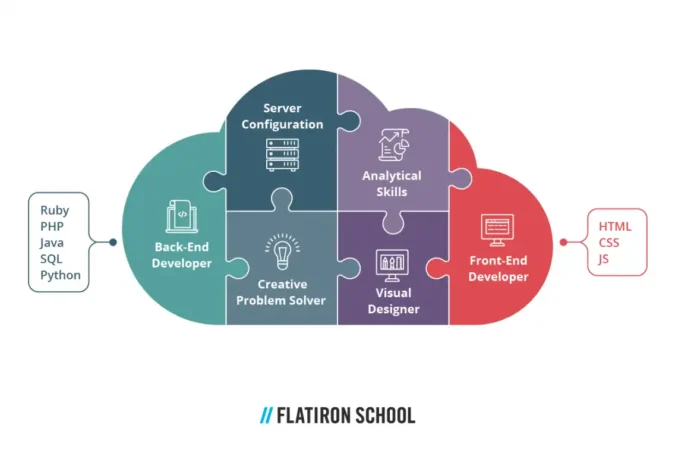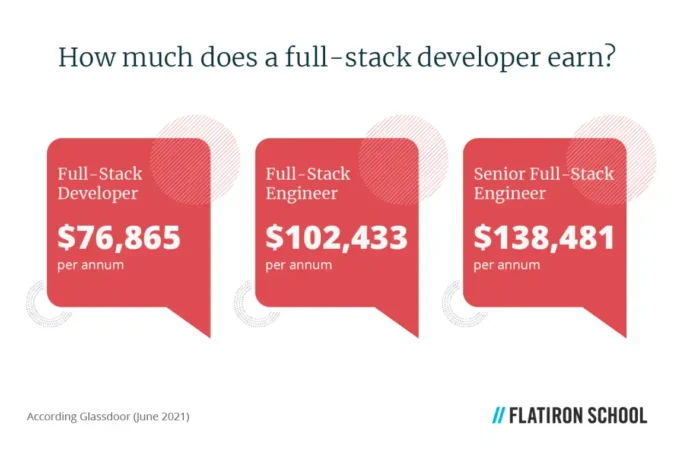
What is a full-stack web developer?
In general, website development is separated into front-end website development and back-end development. A full-stack developer is capable of coding, building, and designing both front-end and back-end elements of a website.
Full-stack web developers are important assets because they can help streamline the build and design process throughout a team. For example, a company could hire fewer developers since they are able to rely on full-stack developers who “know it all.” But, even if your role is specific to either front-end or back-end, becoming a full-stack developer means that you can anticipate questions, needs, or challenges that the other half of your team may have. In turn, this allows you to reduce the back-and-forth conversations that could happen if you didn’t know the full team implications of what you are building.
Some representative skills needed by a full-stack developer are:
- Front-end development languages, such as HTML and CSS
- Back-end development languages, such as Ruby and C++
- Server configuration
- Analytical skills

What does a full-stack web developer do?
A full-stack developer understands how all aspects of both front-end and back-end development work and communicate together in order to make a fully functioning website or application. A full-stack developer is able to write code, work with databases, and also knows how to utilize APIs that connect the front and back-end together.
Since a full-stack developer understands all stages of development, they also often participate in the strategic planning stage since they’re knowledgeable of all development stages.
Depending on the size of an organization, a full-stack developer may be expected to wear even more hats. For example, in a small business, a full-stack developer might also be the network manager, server maintenance personnel, data analyst, or even a sales or customer service person.
Are you suited to be a full-stack web developer?
While a career as a full-stack web developer might sound tempting, make sure this is the right fit for your personality before making that decision.
Being a full-stack developer requires problem-solving skills. You should feel comfortable facing challenges head-on and finding creative solutions. Because the digital world is rapidly growing, you will need to remain curious and continue learning to keep up with the latest technologies. Web development involves life-long learning since technologies change and programming languages get updated. To be a developer, you should be naturally curious, adaptable, and enjoy learning since it will become part of your norm.

Furthermore, many full-stack developers are somewhat artistic or are at least interested in various art forms. The ability to appreciate art allows them to be expressive as they develop the website, especially since full-stack developers are sometimes in charge of visual designs.
How much does a full-stack web developer make?
Now, if you believe you have what it takes to become a full-stack developer, let’s look at the earning potential for this career change.
As of July 2021, the average full-stack developer salary is around $72,000 at entry-level. However, this number increases significantly as the position’s seniority level develops. See below for salary listed by seniority*.
- Full-stack developer: $76,865
- Full-stack engineer: $102,433
- Senior full-stack engineer: $138,481
*The numbers mentioned above came from Glassdoor in June 2021.

Generally speaking, you are more likely to earn a higher wage at one of the tech hubs in the U.S. However, as the option to work remote becomes more prevalent, your opportunities for more high-paying roles will expand.
What should I learn to become a full-stack web developer?
To become a full-stack web developer, you need to learn the skills and languages required of both a front-end and back-end developer.
As a full-stack website developer, you will need to learn both areas. Therefore, understanding the challenges and requirements of each end will help your learning process significantly.

Step 1: Learn front-end web development
You should start with learning front-end web development if you find yourself attracted to the design and experience of a website. For example, maybe you notice cool design tricks used by web pages or are sensitive to difficult navigation. These natural inclinations could make you suited for front-end development.
What is front-end web development?
Front-end web development works with visual elements. The front-end developers are ones transferring designs into the digital space, so you see websites the way they are.
In some cases, a front-end developer works with the design and writing teams to accomplish their tasks.
A front-end developer’s responsibilities
The most crucial responsibility of a front-end developer is to ensure user experience in the browser. Other core responsibilities include:
- Ensure responsiveness across devices
- Ensure site performance, such as page loading speed
- Create the visual design in the browser
- Ensure user interactivity in the front, such as form submissions
How to become a front-end web developer
To become a front-end web developer, you need to acquire the following skills:
- Front-end languages
- Frameworks and code libraries
- How to increase site speed and other performances
- On-site and technical SEO
Fortunately, most of these skills can be learned via various online and in-person resources. You can join a systematic program such as a coding bootcamp, or create a self-paced program and learn these skills little by little.
Besides the hard skills, you should also sharpen your communication and collaboration skills because you will be working with other members on your team, and often directly with the client.
Step 2: Learn back-end web development
If you find yourself more curious about how websites function, then you should definitely start with back-end development. Back-end dev handles everything behind-the-scenes, from server setup and hosting, to creating the logic and algorithm that enables the front-end functionalities.
For example, if you use any web-based applications, the reason those applications work is because of the back-end devs. Therefore, back-end development is also more challenging to learn compared to front-end.
A back-end developer’s responsibilities
As a back-end web developer, your core responsibilities include:
- Building and maintaining web applications
- Safeguarding user data
- Logic, algorithm, and system maintenance
- Server and hosting configuration and maintenance
- API creation, deployment, and maintenance
- QA testing
- Troubleshooting and debugging
How to become a back-end web developer
Once again, start with learning the core skills required by back-end web development. Some of the skills are:
- Back-end development languages
- Net framework
- Data management tools, such as SQL
- Server management
- Hosting Configuration
- Data Security
Compared to front-end devs, back-end development can be more technical. Therefore, when it comes to learning back-end development, we highly recommend you to enroll in a formal learning program, like a coding bootcamp, so you can get the structured learning and guidance you need.
Which programming language should I learn?
You should definitely know more than one programming language. Not only does it make you a more competitive job candidate, but it lets you work on more comprehensive projects.
To become a full-stack web developer, you need to learn both the front and back-end languages.
Front-end languages include:
Back-end languages include:
Should I learn graphic design?
This question doesn’t have a solid answer. However, we highly recommend you familiarize yourself with fundamental design principles. That way, whether you collaborate with a design team or need to create the visuals yourself, you will at least understand how to do the job.
A basic grasp of graphic design principles for the web can help you better work with designers, and understand some of the work that goes into turning a wireframe into a webpage.
How do I become a full-stack web developer?
Thanks to available technology, you have more ways to learn a new skill and start a new career than ever before. While college education is still an option, the heavy burden of student loans and the amount of time you must invest in getting a degree could be intimidating and time consuming.
Bootcamps
Web development bootcamps are one of the most effective ways to become a full-stack web developer. Some programs only take three months to complete, others may take up to six months.
Bootcamps are most suitable for those dedicated to making a career change. These programs are highly intensive, and are focused on teaching you job-ready skills to develop your project portfolio.
These programs are intensive and do require dedication of your time. However, the peer community and 1:1 career coaching support you receive at bootcamps are not something you can easily find via other learning channels.
Free online workshops
There are lots of resources to learn online, including free workshops. These free workshops are a great way to test out if you like the topic and want to dedicate more time to learn coding.
Other resources
If you have previous web development experience, you can also choose to use other learning resources, such as podcasts, audiobooks, and books to create a self-teaching program.
How do I apply to web development bootcamp?
Are you ready to take your first step to a new career? The best way to quickly and efficiently learn the skills you need to become a full-stack developer is in a coding bootcamp.

You can complete a coding bootcamp in as little as 15 weeks or with a flexible pacing option, you can follow the same curriculum and finish in 20, 40, or 60 weeks.
Apply now or book a 10-minute chat with admissions to learn more about the program.
Curious if software engineering is right for you?
Learn more about becoming a full-stack developer
Frequently Asked Questions
Not all web developers are full-stack developers, but full-stack developers fall under the larger category of web developers. A full-stack developer is responsible for developing and maintaining both front-end and back-end development skills.
Job demand continues to grow as more companies embark on the digitalization adventure. It is a secure career path with plenty of growth opportunities.
Yes, but we recommend you enroll in a coding bootcamp if you are on a tight timeline. You can complete a coding bootcamp in as little as 15 weeks, or try a flexible pace option that can work around your already-busy schedule.
Flatiron School offers a coding bootcamp that you can complete in 15 weeks if you are able to dedicate full-time hours to the program. Otherwise, you can look into teaching yourself the basics with online lessons.
Learning full-stack development can be challenging since you will need to learn several programming languages. It is definitely more challenging than learning only front-end or back-end development.
Yes, anyone who is willing to work hard to learn several coding languages can become a full-stack developer. You’ll also need to lean on your problem-solving skills and critical thinking to help you thrive as a full-stack developer.
The most effective way to become a full-stack developer is to join a coding bootcamp. You can check out our free lessons and discover what you’ll learn.
On average, entry-level full-stack web developers earn around $77,000 a year, according to Glassdoor in June 2021. However, if you’re in a tech hub, you could easily reach a high-end pay of over $108k per year.
You can choose to teach yourself using existing resources or sign up for a web development bootcamp.





